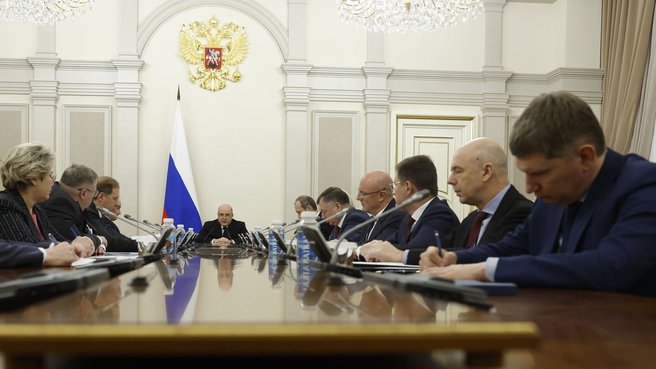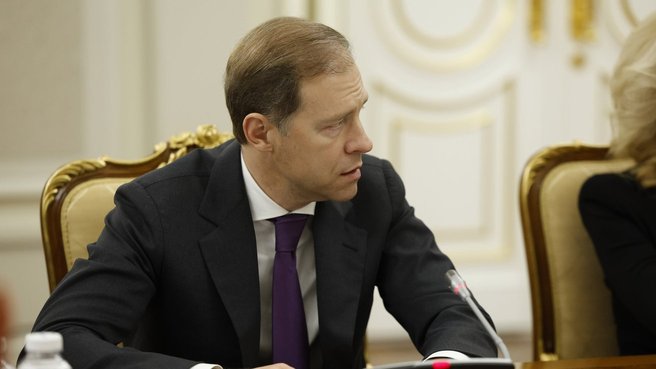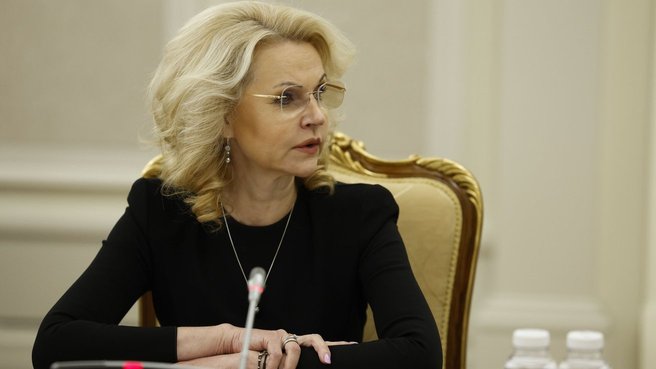Agenda: A comprehensive programme to boost aircraft manufacturing, the implementation of the Automobile Industry Development Strategy, the year’s results related to culture.
Mikhail Mishustin’s opening remarks
Denis
Manturov’s report on the implementation of the Automobile Industry Development
Strategy
Tatyana Golikova’s report on the year’s results related to culture
Excerpts from the transcript:
Mikhail Mishustin: Good morning, colleagues.
Let us begin with a decision that is intended to attain the objectives set by the President to develop the aircraft industry and boost the manufacture of civilian aircraft.
The Government has adopted a comprehensive programme to expand production of aircraft, engines, tools and equipment. It also authorised the use of funding from the National Wealth Fund for this purpose. Over 280 billion roubles can be allocated on a repayable basis.
The document provides for the technical readjustment of enterprises, increasing industrial capacity and conducting research and development work, including the creation of new materials and an electronic database of parts.
In the next six years, over 600 Russian-made aircraft must be manufactured. The base of the Russian airline fleet will be Superjets and the flagship MS-21s, complemented by the regional Il-114s and highly reliable medium-haul Tu-214s, as well as the wide-bodied Il-96-300s.
Amid the sanctions pressure, our own contemporary aircraft fleet is of utmost importance for the connectivity of the regions of our big country.
Another issue is related to reaching technological sovereignty.
At the President’s instruction, the Automobile Industry Development Strategy is being implemented until 2035. Russian car manufacturers are facing large-scale tasks.
Over the next few years, it is necessary to increase the output of Russian-made cars and buses, partly by relaunching plants that belonged to foreign companies which left the market, as well as through deepening localisation by stimulating our own research and engineering competencies, and competitive production of key car parts.
Mr Manturov, please tell us in detail about the work carried out over the past year as part of the Automobile Industry Development Strategy. What are the future plans? We are excited to learn more.
Denis Manturov: Mr Mishustin, colleagues. Updating the strategy is a prompt response to the changing economic environment. The past year showed that the Government and the sector have set the right priorities in their work. We managed to deal with the main strategic goals while maintaining competencies and manufacturing workforce. We have found Russian investors for almost every platform that the foreign companies left. We also outlined a pool of technological partners and are gradually launching the production of new models. This includes facilities in Tatarstan, the Kaluga Region, St Petersburg, Kaliningrad, and the Far East.
In addition to an increasing output at our flagship companies – AvtoVAZ, GAZ, KamAZ, UAZ, Ural – it helped to restore the sector. Last year, output increased by 16 percent; 720,000 vehicles in various segments were manufactured in Russia. Overall, more than 1.3 million new automobiles of all types were sold in the domestic market.
An important aspect of the sector’s renewal are programmes aimed to promote demand for Russian-made cars. The state allocated some 16 billion roubles for concessional leasing and loan programmes, which provided for selling 62,000 autos. With your support, Mr Mishustin, the Government allocated funding to continue this programme in 2024. Moreover, at the instruction of the President, which he gave in Anadyr last week, we are ready to launch a programme for concessional purchases of cars for large families in the Far East.
Making cars environmentally friendly is as important priority of the strategy. I mean continuing to transition part of the fleet to natural gas, and, of course, increase the production of electric and hybrid cars.
In the passenger car segment, we launched manufacturing in this segment in Lipetsk and Moscow, and in the next three years, AvtoVAZ, Kama and Avtotor plan to bring new models to market.
As for light commercial vehicles, we already have full electric models from GAZ and UAZ. We also have extensive experience in manufacturing buses; Moscow currently has the biggest electric bus fleet in Europe. There are 1,400 buses total, all of them were made in Russia.
The further development of green transport will also be supported by the state. We are already implementing various measures for gas and electric vehicles.
As you said, the common objective for all types of vehicles is to increase the production of parts. To that end, in 2022, a special programme under the Industrial Development Fund was launched that has already supported 31 project worth 53 billion roubles. Late last year, the fund received an additional 55 billion roubles. Most of this amount will be allocated for the localisation of automotive parts and components.
In this area, we will prioritise the sovereign segment of passenger and light commercial vehicles. Dealing with this strategic goal will help create new production chains that will be protected from the sanctions. I am talking about the creation of hundreds of small and medium-sized companies that will cooperate to replace global suppliers.
The same approach will be used for other segments with a higher share of state procurement. This includes vehicles to renew the fleet for the healthcare and education systems.
Last year, the Government provided for the delivery of over 3,000 school buses to the regions, as well as 1,200 ambulances and 200 mobile medical units. Most of them were supplied to the Donetsk and Lugansk people’s republics, as well as the Zaporozhye and Kherson regions. Over 230 vehicles for mobile street traders will be delivered to these and the adjacent regions. Due to the prompt response of our manufacturers, we can also support the military personnel in the special military operation zone. In coordination with the Popular Front, we are concluding the delivery of 1,500 UAZ Patriot cars.
In conclusion, I would like to say that the sector is steadily restoring its position and is ready to reach the goals you have set for the medium and long term.
Mikhail Mishustin: Thank you, Mr Manturov.
In this area, we must do everything we can to ensure that the Russian auto industry increases the number of vehicles produced, their efficiency and environmental friendliness.
And it is very important that the production of cars with promising drive systems is established in Russia. We are primarily talking about electric, hybrid, and hydrogen power units. These vehicles are in demand now. Their spread and the opportunity to occupy new, vacated niches will benefit the environment.
And now, more on the development of cultural events in the country.
During the New Year holidays, our citizens travelled quite actively across Russia to see beautiful historical places. In the first week of the year, about a million people visited nature reserves, museums and exhibitions. More than 200,000 people went to theatres.
Interest in Russian films is also growing. We see this in the statistics of the cinemas themselves. In the first days of the New Year alone, over 14 million people watched Russian films. The number of tickets sold during these January holidays increased by 10.5 percent.
Ms Golikova, what cultural events did people prefer during the New Year holidays. And in general, tell us about the main results in this area in the past year.
Tatyana Golikova: Mr Mishustin, colleagues.
In terms of cultural events, the past New Year holidays pleased us with exciting events. First, I would like to talk about cinema screenings, as we can see here most positive changes and results.
I would like to start with the fact that at the beginning of 2020, additional financial resources were allocated for the production of domestic films on the instructions of the President and on your instructions. And given that the film production cycle is three years, we are now seeing the results. And these results are being seen by audiences themselves.
In the first week of the new year, box office receipts totalled 5.8 billion roubles with 95 per cent coming from domestic films, that is, 5.5 billion roubles. Russian cinemas have never received higher box office receipts during any New Year holidays in previous periods. This is an absolute record.
The average daily box office receipts from ticket sales totalled 724 million roubles, which is 165.5 million roubles more than in the same period last year. We are seeing real interest from audiences in domestic cinema. Our average daily attendance during this period was 1.8 million, also a significant increase: 175,000 more people came to the cinemas every day than on the same days last year. This is a very good result.
The box office leaders were (it is common knowledge, as they say) the films ”Serf 2,“ ”The Bremen Musicians,“ ”The Three Bogatyrs and the Navel of the Earth.“ And further in January we expect new films – and not only in January, but in the first quarter in general.
You mentioned a figure: more than 14 million visits over the New Year holidays. Yes, there were 14.8 million visits in total, of which 14.2 million were domestic films. And this, of course, made a big difference in revenue: the revenue of these New Year's holidays exceeded 2020 by 38 percent, the pre-pandemic year. This is also a very good result.
And we have roughly estimated that January's domestic box office receipts will be equal to all of 2016. This is our current estimate.
Now to the theatres: during the New Year holidays (for now, we only have data for the federal theatres), almost 20 percent more people visited the federal theatres than in the same period in 2023. It is important that the theatres have returned to pre-pandemic levels, which means we are fully restored.
The Russian State Circus also presented programmes for children. Since the beginning of the year, 700 performances were held and more than 900,000 people watched them. This is also 1.5 times more than in the same period last year.
I would especially like to note that the Russian State Circus held 24 performances at the Lugansk State Circus during the New Year holidays and these performances were attended by more than 30,000 people living in the Lugansk People's Republic and other regions.
The federal museums sold 335 million roubles worth of tickets during January 1–8, which is 17 percent more than over the same period last year. This is also quite a result.
We see a growing interest from our citizens and foreign tourists in what our museums display both in the capital and in other regions.
I cannot help but mention the flagship project, the Pushkin Card. Over the three years of the project, the Pushkin Card has begun to play an increasingly important role in the cultural life of Russa. Today, almost 10 million young people aged 14 to 22 have participated in the programme. In recent months, people in the new regions have begun to join the programme: more than 1,600 people in the Donetsk and Lugansk people's republics, and the Kherson and Zaporozhye regions now. Work in this area continues.
Today there are almost 12,000 participating institutions, and the number of shows tickets to which can be purchased with the Pushkin Card is over 472,000, which is several times higher than we planned when we were launching this project.
The absolute leaders among theatres and museums are Peterhof, St Isaac's Cathedral, the Hermitage, the Tretyakov Gallery, the Russian Museum, the Pushkin State Museum of Fine Arts, the Mariinsky Theatre, and the Novosibirsk State Academic Opera and Ballet Theatre. I mean the Pushkin Card. Among the regions, in addition to the two capitals, Moscow and St Petersburg, the Republic of Mari El, the Chuvash Republic, the Republic of Tatarstan and the Nizhny Novgorod region stand out.
Summing up, I would like to say that the culture industry has not only returned to pre-pandemic indicators but exceeded them, and film distribution, despite the departure of American and European films, is even showing very good indicators. Evidence of this is the receipts and attention of our viewers to domestic cinema.
Mikhail Mishustin: These are really very good results for our cultural efforts. When we discussed the idea of the Pushkin Card with the President, we talked about the high quality of the product that should be incorporated into the content of our theatres, museums, exhibitions and excursions.
And indeed, today, demand from people, including children, for these products is increasing, which cannot but please us.
All the necessary funding has been earmarked in the federal budget, so we will provide everyone with the appropriate resources to ensure that the Pushkin Card project continues to make progress.
Once again, I would like to thank all of you who have been working on this.
It is important to continue to develop such areas so that people have more opportunities to attend a high-quality modern or classical theatre production, go on tours of historical sites, watch a good film, or visit an exhibition of paintings. In other words, to broaden their horizons. All this enriches people's inner world and, importantly, raises interest in their native culture and traditions.










